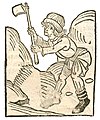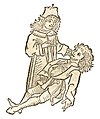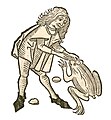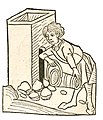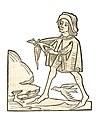
A bestiary is a compendium of beasts. Originating in the ancient world, bestiaries were made popular in the Middle Ages in illustrated volumes that described various animals and even rocks. The natural history and illustration of each beast was usually accompanied by a moral lesson. This reflected the belief that the world itself was the Word of God and that every living thing had its own special meaning. For example, the pelican, which was believed to tear open its breast to bring its young to life with its own blood, was a living representation of Jesus. Thus the bestiary is also a reference to the symbolic language of animals in Western Christian art and literature.
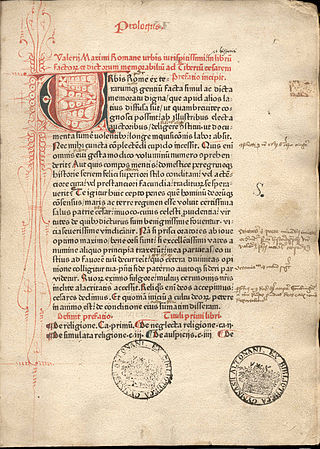
An incunable or incunabulum is a book, pamphlet, or broadside that was printed in the earliest stages of printing in Europe, up to the year 1500. The specific date is essentially arbitrary, but the number of printed book editions exploded in the following century, so that all incunabula, produced before the printing press became widespread in Europe, are rare, where even some early 16th-century books are relatively common.

Manna, sometimes or archaically spelled mana, is described in the Bible and the Quran as an edible substance that God bestowed upon the Israelites while they were wandering the desert during the 40-year period that followed the Exodus and preceded the conquest of Canaan.

A herbal is a book containing the names and descriptions of plants, usually with information on their medicinal, tonic, culinary, toxic, hallucinatory, aromatic, or magical powers, and the legends associated with them. A herbal may also classify the plants it describes, may give recipes for herbal extracts, tinctures, or potions, and sometimes include mineral and animal medicaments in addition to those obtained from plants. Herbals were often illustrated to assist plant identification.

Otto Brunfels was a German theologian and botanist. Carl von Linné listed him among the "Fathers of Botany".
Conrad Dasypodius was a Swiss astronomer, mathematician, and writer. He was a professor of mathematics in Strasbourg, Alsace. He was born in Frauenfeld, Thurgau, Switzerland. His first name was also rendered as Konrad or Conradus or Cunradus, and his last name has been alternatively stated as Rauchfuss, Rauchfuß, and Hasenfratz. He was the son of Petrus Dasypodius, a humanist and lexicographer.

Peter of Ravenna was an Italian jurist. He is now best known for his memorization techniques, published in a 1491 work Phoenix (Fenix) on the art of memory, a work that received an early form of copyright.

Johannes Mentelin, sometimes also spelled Mentlin, was a pioneering German book printer and bookseller. In 1466 he printed and published the first German language Bible.

Heinrich Eggestein is considered, along with Johannes Mentelin, to be the earliest book printer in Strasbourg and therefore one of the earliest anywhere in Europe outside Mainz.

Matthias Bernegger was a German philologist, astronomer, university professor and writer of Latin works.
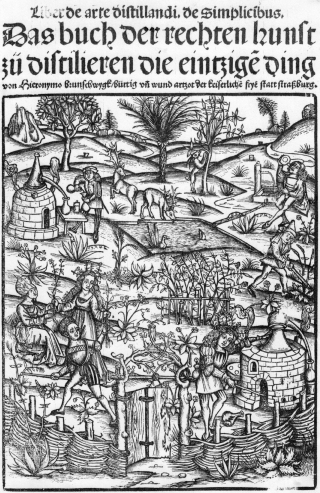
Hieronymus Brunschwig or Hieronymus Brunschwygk was a German surgeon ("Wundarzt"), alchemist and botanist. He was notable for his methods of treatment of gunshot wounds and for his early work on distillation techniques. His most influential book was the Liber de arte distillandi de simplicibus.
The following is a timeline of the history of the city of Strasbourg, Alsace, France.

Johann von Wonnecke Caub or Johannes de Cuba, is the attributed author of an early printed book on natural history, which was published in Mainz by Peter Schöffer in 1485 under the name of Gart der Gesundheit.

Gottfried von Hagenau was a medieval priest, physician, theologian and poet from Alsace. As his name suggests, he was probably born in Haguenau, before 1275.

The Gart der Gesundheit was edited in 1485. It was written by Johann Wonnecke von Kaub and was one of the first printed herbals in German. It was often reprinted until the 18th century. The Gart der Gesundheit is an important late medieval work concerning the knowledge of natural history, especially that of medicinal plants. In 435 chapters 382 plants, 25 drugs from the animal kingdom and 28 minerals are described and illustrated. The book was edited by Peter Schöffer in Mainz. Together with the Latin Herbarius moguntinus and the Latin Hortus sanitatis, the Gart der Gesundheit belongs to the "group of Mainz herbal incunabula".

Herbarius moguntinus or Aggregator practicus de simplicibus is an illustrated Latin herbal which was edited and printed in 1484 by Peter Schöffer in Mainz. Together with the German herbal Gart der Gesundheit and the Latin herbal Hortus sanitatis, Herbarius moguntinus belongs to the so-called "Group of Mainz Herbal Incunabula."

Peter Schöffer the Younger was a German printer, the son of Peter Schöffer, a former apprentice of Johannes Gutenberg, and a grandson of Gutenberg's financier Johann Fust. He first worked in Mainz, where he set up his first workshop. He was an expert type caster, and his specialty was printing music. Schöffer moved to Worms in 1518, where he printed among other works the Tyndale Bible, which was the first mass-produced English edition of the New Testament, and the first complete German Protestant translation of the Bible. Later in life, he also worked in Straßburg, Venice and Basel.

The Liber de arte distillandi de simplicibus is a German book by Hieronymus Brunschwig published on 8 May 1500 by Johann Grüninger. It was the first book on the subject of distillation written in the German language, and was also the first book on chemistry published in the English vernacular. The Liber consists of a manual on how to distill medicinal waters, and combines traditional practices with technical instructions.

Lorenz Fries, also called Lorenz Phryes, Latinized Laurentius Frisius or Phrisius was a German physician, astrologer and cartographer, who worked mainly in Alsace. His most famous work is the “Spiegel der Arznei” , one of the earliest works on medicine in the German language. His cartographic work continued that of Martin Waldseemüller in assimilating recent discoveries in the New World and Asia into the classical Ptolemaic framework.


































